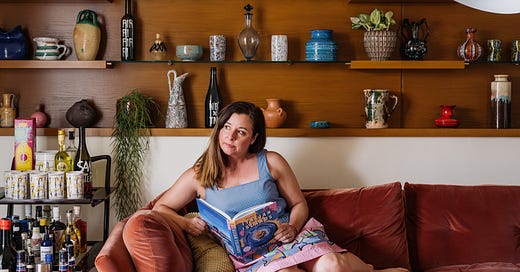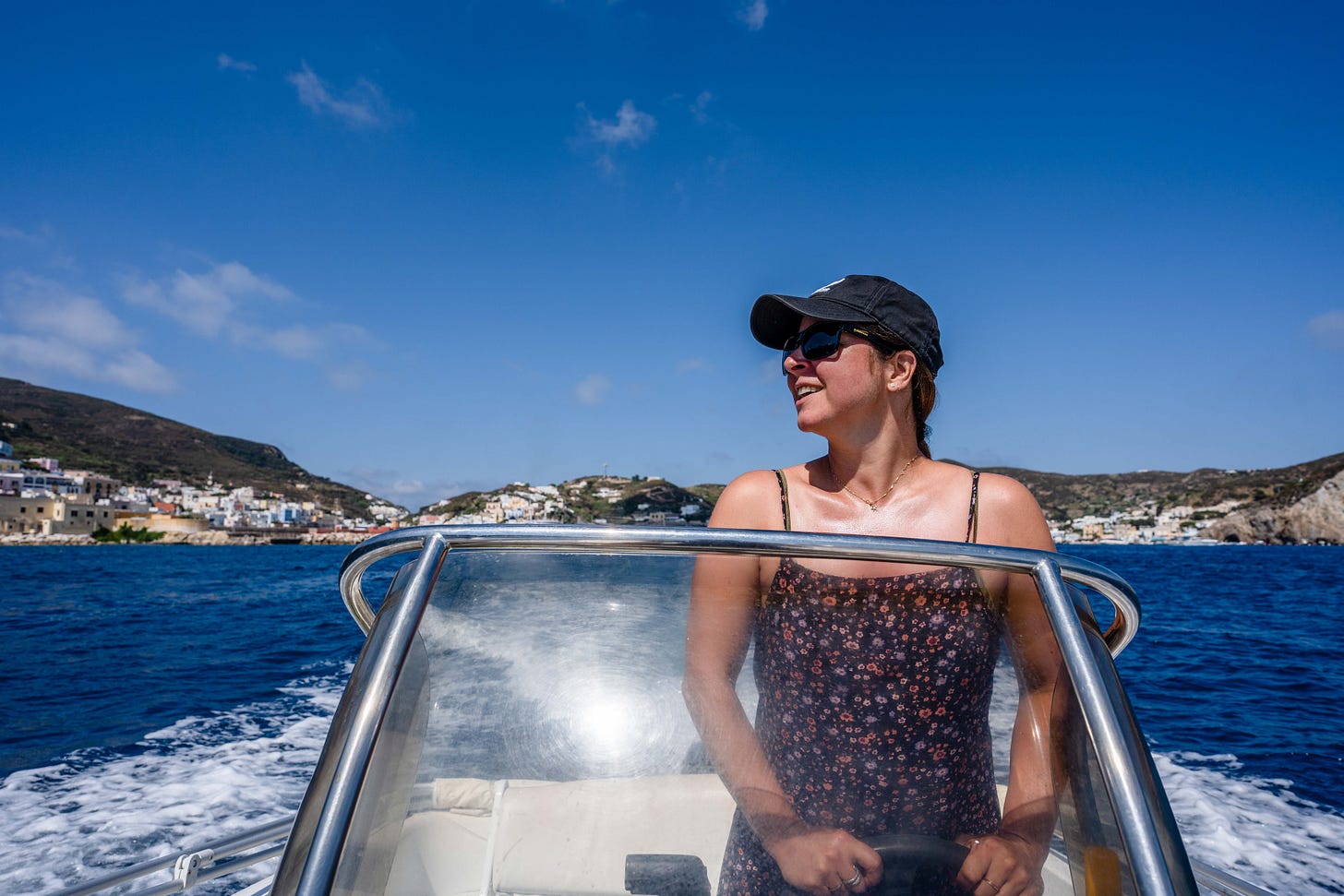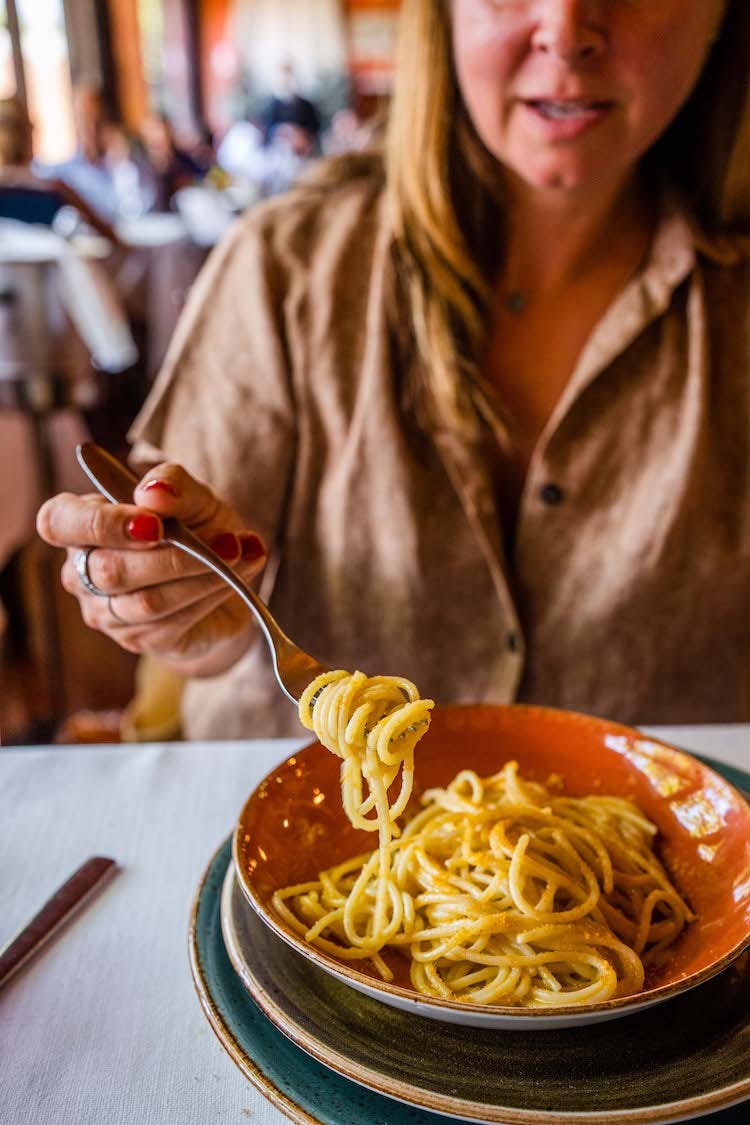Some of the Tastiest Bites in Italy Aren't Italian with Katie Parla - No. 19
And a look into the life of a food and beverage writer.
Welcome to Vegarie! If you haven’t already, please subscribe (while it’s still free!) and you'll receive my biweekly newsletter on Tuesdays where I interview women in food—chefs, restauranteurs, writers, and creatives—all with unique, nerdy-passionate opinions on food.
This week’s post features Katie Parla, a Rome-based food and beverage writer, culinary guide, and New York Times bestselling cookbook author. Working within a ton of platforms in the food space over the last 20 years, Katie also gives weekly food tours in Rome, co-hosts the Gola Podcast, and works as a story producer, on-screen expert, and host of television shows focused on Italy’s food and history. Together, we talk about her experience with self-publication via her newest cookbook Food of the Italian Islands, life as a food and travel writer, and her obsession with Italian culture from an early age. Plus! Katie shares a bit about her favorite bites in Rome, which to my surprise, are not Italian. Katie’s story is incredibly inspiring and her tips are insightful for any creative, whether in the food space or not. If you’re interested in learning more about a career in food writing, bringing your creative project to life, or making a big’ol bowl of pasta, this chat is for you.
First things first, we dove into Katie’s newest book, Food of the Italian Islands, which came out in March. Islands gives the reader a deep dive into Palermo, the hometown of Katie’s great grandfather, into Sardinian kitchens to learn intricate pasta shapes, and to Ponza where they dive for sea urchins. Similar to the structure and approach of her previous book, Food of the Italian South, Katie is especially proud of the overall look and feel that she was able to establish through her first experience with self-publication. The process allowed her to collaborate with an incredible photographer and designer to establish a look that was deeply personal to her experience—the bold flavors of the recipes mirrored by the boldness of the color palette. Katie tells me, “their design work would have been dumbed down and dulled by a corporate publishing entity. But the biggest difference with self-publication is that I'm able to make money, whereas I lost money making Italian South.”
Yes, years of working within publishing helped Katie to accomplish this project, but after this experience, she’d recommend self-publication to anyone. When you go this route, “having a half-decent platform and ability to do moderate sales is all you need to start making money.” Compared to signing a contract with a large cookbook publisher that is— where you may be given an advance on royalties, but end up spending it all to make the book. Working with a publisher covers the design, printing, and distribution. What you learn, however, is that you have to pay for the typography, research, development, publicity, marketing, and testing on your own. “It's like $12,000, to test a cookbook. You would need a pretty fat advance to walk away with any money at all. And if you do, it's pennies for your work.”
After explaining, Katie revises a bit—she maybe wouldn’t suggest self-publication to just anyone, because it does require a certain amount of capital and risk. From a potential profit standpoint, she still stands by going that route if you can. If you want to learn more about the publication process, Katie shares more about her experience in this episode of the Gola Podcast. You should give it a listen!
Outside of the pride that Katie carries for the design of Islands, she’s also excited to share the pasta appendix she created. Within the appendix are QR codes that go to videos, either of Katie or artisans from Italian Islands like Sardinia, that show proper pinching or shaping of different types of pasta.
“Can I paint a picture with words about how to fold tortellini? Yes. But I think a visual aspect is helpful for people who have a difficult time following directions— I would include myself in that group. It makes pasta making more accessible. And some of the pasta shapes are quite rare, so I firmly believe that the more people make them, the better it is for the preservation of the tradition.”
If you’re like me, you’re probably wondering, how did Katie find herself in this super niche corner of the food world? How did a gal from New Jersey end up writing about Italian food and culture, and find themselves feeling at home in Italy? Maybe you’re thinking, that couldn’t have been easy! Well, you’d be right.
“I visited when I was a high school sophomore on a school trip. Italy was nothing like what I expected— the food was bad, we all got pickpocketed. It was a crazy weird late 90s seedy moment in Rome. but I was totally obsessed from the jump.”
From the age of 16, Katie was determined to move to Italy. Seedy or not. When she returned to New Jersey, she immediately signed up for Italian courses at her local community college. She knew she’d return, and do it right. Intrigued by culture and history, Katie studied Art History at Yale while keeping up with her Italian. While in college, she also worked at a local pizzeria and was always very interested in the hospitality aspect of the service industry. She eventually took the love of hospitality into her own hands, “throwing a lot of parties and transforming [her] off-campus apartment into a point of reference for food, and mostly, drinks.”
Originally, she thought that she would continue to study Art History in Rome post-grad, but shifted course when she saw the availability of food and wine culture classes. “Almost instantly,” she said, “I turned my attention to wine. I did a sommelier certification pretty early on, kind of as a way to improve my Italian. It felt low-stakes and ended up being really fun.”
Katie didn’t stop there, she continued on to get her Master’s in Italian Food and Culture at the University of Rome. Guidebooks were Katie’s entry point to the food writing world. It’s no surprise that her background in Art History lent itself to writing in this format as well. Upon landing in Rome with no job prospects, she wrote letters to guidebook companies fishing for an opportunity— think Rough Guides, DK, Eyewitness, Lonely Planet, all of them. Katie insists that her success in this came from the “high turnover for freelancers at that time in the travel industry. Eventually, you know, my letter came to the top of the pile.” However, five years later, Katie had written over 20 guidebooks. Which tells me, her success had a lot more to do with her ability and determination.
In the early days, Katie was also teaching and leading private tourism—hence the birth of her legendary food tours. To this day, she spends her days in Rome meeting with clients for three-hour immersive tours of a neighborhood, where they agree upon a vehicle for decoding the culture of that space. Sometimes she'll do a second in the afternoon or evening if she doesn’t have to head into calls with editors—right now she spends most evenings writing a book for a restaurant in Los Angeles. “The bulk of my writing doesn’t happen until the evening, basically from 6 pm until 2 am, or until the assignment is done.” Sometimes that means writing a listicle, a personal essay, a chapter of a cookbook—Katie, do you sleep?! I’m convinced you do not.
“I try to be an ambassador for Italian food culture; to kind of teach people to break away from the romantic stereotype and learn about the history and culture as it functions on the ground in Italy.”
Tours have become the vehicle with which Katie can connect with people and connect them to Rome. Over time, they have become the most gratifying part of her career. The thesis of her tours is, “Yes, we're eating as we go. But I'm also going to help you decipher this culture.” Sometimes that means they’re learning something service-oriented, like how to navigate a bakery counter. And sometimes it's more along the lines of diving into a street-food movement and what that says about the economy, appetite, and changing tastes of Italy. “At the end of three hours, we've accomplished something. At the end of three hours of writing, I might have deleted 16,000 words. And so they're really, really different ways of working.”
Finally, a little about what is inspiring Katie right now. What is she eating and reading, you ask? Well, just as the title teases, Katie tells me the best food in Rome is not Italian— it’s Ethiopian. That’s right, “[her] favorite places in Rome historically aren’t Italian at all.” Laughing nervously, she explains that it's not to say the Italian food isn’t amazing there. “Anyone that hearing that here would think I'm crazy,” she says, but “Italian cuisines are endlessly interesting and the people creating the food are incredibly fascinating.” It’s that very reason, however, that the obsession with Italian culture overshadows other prevalent influences. The influence of the Ethiopian and Eternian populations in Rome’s food scene is major. Next time you’re there, look around the neighborhoods directly surrounding Termini Station, or in the Eastern periphery areas, these will be your sweet spots for Ethiopian and Eternian food.
As for what she’s reading, the CDMX Taco cookbook comes to mind. “It was independently published by a collective, it's visually arresting as a bright yellow cover. It’s so photo-driven. They've leveraged photography to build a narrative of the City. It’s a refreshing break in a mold.”
When it comes to tips that Katie can pass along, she assures me the most important things are very simple. Education and awareness of the value of your lived experience brings to the table are key to any field. “Educating yourself is super important. Anyone can speak about these topics, deeply knowing them is something else.” Education could take all sorts of forms from apprenticeship, academic study, casual research, or traveling. For Katie, the best move was to pursue her Italian Master's degree in the subject. For others, it could look different. As to the second part of her advice, Katie struggled to recognizing her value early on. She explains that she wished she had vouched for herself earlier, for “many years, I was making a lot of money for other people—be it through their events, or publishers. It took a long, long time to realize the value that my experiences added.”
Katie, I can’t thank you enough for sharing your story with me. It’s inspiring women like you who remind me why I love this industry and all that it’s about — caring for a community and bonding over a shared love of food. Please, please, please go check out her new book, or follow her on Instagram to keep up with her adventures and recipes if you haven’t already.







